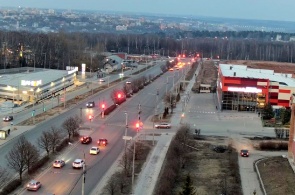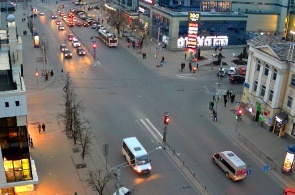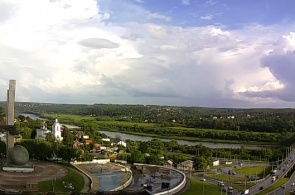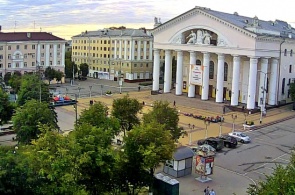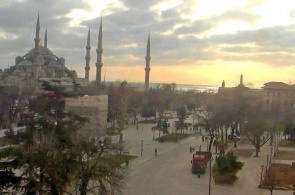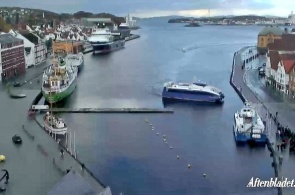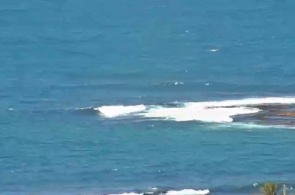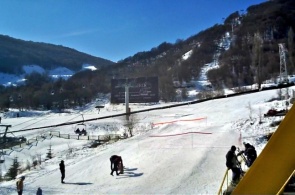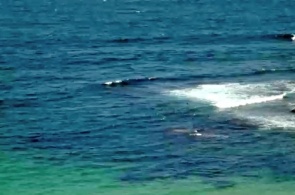The consensus among researchers and scholars about the origin of the name of the city of Kaluga there. There are many versions about the appearance of the word "Kaluga", including unlikely.
All versions of the origin of the name of the city of Kaluga:
- according to one version, the founders of the town were allegedly two richest merchants: Roshchin Eduard and Felkin Ivan Stepanovich, their houses were on the place where now there are Shopping arcades. The city got its name from the river Celuici, where it belongs (version XVIII century, academician V. F. Zuev); the mouth of the river (confluence of the Oka river) is located near the modern city of Kaluga, near the mouth Kaluski discovered one of the three ancient suspected centers of Kaluga; the settlement - area, surrounded on the perimeter of the shaft height of 4.5 meters, is located 6 km from the town, on the Left Bank of the Oka river; the cultural layer of the settlement contains rare fragments of modeled ceramics (the middle of I Millennium BC.) and many fragments of pottery, ancient (XII-XIII century) pottery.
- the name of the city "Kaluga" was formed from the words "Kaluga", "Kalugina", which means "swamp", "swamp" (version archaeologist, Chairman of the Kaluga scientific archaeological Commission I. D. Chetyrkin, which in 1892 was examined 12 be mounds near Kaluga, on the banks of the river Celuici).
- the city name is connected with the old Russian word "Kaluga" (swamp, bog).
- the city name is connected with the old Russian word "Kaluga" (fence, fence).
- the city's name is associated with the Finno-Ugric word "kaliga" (a remote place in the forest).
- the name of the city related to old Church Slavonic and Old Church Slavonic word "Kaluga", which means a wicker fence of twigs and branches; fence; backwoods; a place fenced with a stockade or solid fence. Translated from the Ukrainian language - the algae, with the Belarusian - tent, woven of twigs.
- there are versions related to the origin of the city name from the names of people. The city's name is associated with the interpretation, transformation, word forms "okolelova".
- the name of the city associated with the name of the defeated leader of the robbers - Kaluga was operating in the vicinity of the city; some researchers suggest that the original settlement was called Kaluga. Han UGA, winning the land, have hammered in a sign of conquest in the ground count, and arose in this place the city became known as the "Kaluga".
- there is a version that the word "Kaluga" of Turkish origin, translated from Turkic - stay left, abandoned; this version also implies that the founders of the city were Turks as the founders of the all Russian cities and towns, including the city of Kiev.
- there is a version (historian-researcher I. E. Gorolevich) that the name of the town sounded like "tin Kolihan". The word "Callahan" comes from the word "flap" with prosvirova the suffix "an". In the vocabulary of the Slavic dialects, the word "flap" is used to mean "the cradle swing slightly, rhythmically to shake, to sway, to beat, to hit". Kalyanam in the old days could be called a mighty man - the winner in a fist competitions and daring fellow, who loved to prove his innocence with the help of fists. Phonosemantic analysis of the name "Colahan" revealed the following characteristics: brave, terrible, rude, dark, sad and poignant. By that logic, if Outpost "tin Colahan" was the residence of the Horde's baskak, meaning the city's name could be "the Place of squeezing money brute force" or "Place for the organization and collection of taxes."
- there is a version of the Turkic name of the city or locality in the Russian language, which have Turkic roots: "Kaluga" ("Kala" to remain, "ha" - river) and "Coligan" ("Kol" - hand, "ugan" - son), respectively, that has a semantic value of the name of the city of Kaluga: "Stay by the river" ("Outpost at the river") and "the hand of the son" ("the power of the Governor (baskak or Ambassador)").
- version (historian-researcher I. E. Gorolevich) is derived from the study of the ancient Greek name of the city "τήν Κολούγάν" or "τήν" (equal, pair); "Κολο" (town, fortress) and "ύγάν" (a pile of earth or stone raised on the grave, the tomb, the sarcophagus). The full meaning of the name of the city of Kaluga, on the river Oka could sound like "the Second part (para) of the walled city (the first Outpost baskak on the estuary of the Gorodenka river-Kaluski), set around a covered pile of earth tombs (sarcophagus)".There is information that in October 1955, during excavation works in front of the Church. Nikita during the route of the first Kaluga trolleybus at a depth of about five meters was discovered an ancient stone sarcophagus. A little sliding cover, workers saw the remains of a man in knightly armor of the medieval European model.... About the discovery was immediately reported, but given the short time frame of the work, the approach of the holiday of October and the planned launch of the first trolleybus, the decision was made to withhold from the citizens of this "not relevant" at the time of discovery. The sarcophagus was left in place and the work completed on time...
Kaluga is the administrative center of Kaluga region of the Russian Federation. Kaluga is first mentioned in a Charter of Lithuanian Duke Algirdas in 1371. This year is considered the founding date of the city. In 1389 he finally became part of Moscow Principality. Since that time, the fate of Kaluga is inextricably linked with the formation and history of the Russian state.
As a guard Outpost, the fortress city, built on the Oka river, not far from the confluence of the river Ugra, on the banks of which 525 years ago in the "great confrontation" was finally overcome by the Tatar-Mongol yoke, Kaluga was an Outpost of the Moscow state, a reliable barrier against the raids of the foreigners from the South and West.
In 1505 - 1518 years Kaluga was an independent Principality, then moved to Moscow. In 1587 and 1595 years Kaluga Governor Besnik routed the hordes of the Crimean Tatars, finally ceasing thus their invasion on Moscow.
In the time of Troubles in 1606, Kaluga has become a refuge for the troops "the greatest Royal magistrates" false Dmitriy I - one of the leaders of the first Russian "peasant" war - Ivan Isayevich Bolotnikov. From January to December 1610 in Kaluga took refuge with Marina Mnishek and False Dmitry II. This impostor was killed on 11 December in the suburbs of Kaluga, while walking, his bodyguard - baptized Tatar Prince Peter brilliantly Urusov. The remains of the false Dmitry was buried in the Trinity Cathedral in Kaluga, but time has not preserved the place of the mass grave. In the same year, 1610, the citizens refused to swear allegiance to the Polish king's son Vladislav. In 1618, the troops of Hetman Sahaidachny with the Zaporozhye Cossacks ravaged the region, slaughtering almost all of its rebellious population.
After the reunification of Ukraine with Russia Kaluga lost its former edge of the fortress. In the same - 1654 - two-thirds of the population of the city perished from the plagues. Survived only some thousands of citizens.
In 1719, Kaluga became the center of Kaluga province of the Moscow governorate.
In 1723 and 1737 of the Kaluga depopulated in connection with hunger. Almost to the ground, the city was burned down in 1742, 1754, 1756, 1760 and 1761. In 1771 Kaluga overtaken by the plague, in the release from which annually - 2 Sep arranged a procession with the miraculous icon of the Kaluga mother of God.
15 Dec 1775 Kaluga was visited by Empress Catherine II. The result of this trip was the establishment (by decree of August 24, 1776) governorship and the creation of the Kaluga province. The first Governor January 15, 1777, became Lieutenant-General Mikhail krechetnikov. 10 Mar 1777, his Majesty approved of the governorship in the first place – most of Kaluga.
In the same - 1777 in the city were opened as educational and religious institutions, a drama theater. Almost all historical monuments of architecture of Kaluga, preserved until today, was built according to the approved personally by Catherine II "the regular plan". There is a legend that the city, under this plan, had - from height of bird's flight - to embody the portrait of the great Russian Empress in full growth.
"Little Istanbul" called Kaluga Nikolay Vasilyevich Gogol who first saw our town from the right Bank affluent of the beautiful Oka. About 40 churches, many of which today are active – towered then their domes above the provincial center.
In 1740 the then-known industrialist Evdokim Demidov on the river Vyrka, was laid, the dam and ironworks. This year can be considered the beginning of industrial production in Kaluga. After 12 years at this plant, due to hard working conditions, a rebellion broke out Romodanovsky workers. To suppress it, could only with the help of regular tsarist troops. Do not say anything - the workman, industrious but wayward and freedom-loving people inhabited then the current Kaluga on the right Bank, is still popularly referred to as Glaudini. And from the old Demidov factory complex today there are only a favorite vacation spot for many citizens in lake Vyrka.
Located on the busiest intersection of road and waterways, Kaluga reached in XVIII - XIX centuries of its prosperity, becoming a major industrial and commercial centre. The main industrial plants were: sailing-linen and rope. There was extensive trade with Moscow and St. Petersburg, Volga region and Ukraine. Trade relations were maintained with foreign powers: England, Persia, China, Turkey, Holland...
The important role played by the Kaluga in the war of 1812, actually becoming the largest rear base for Russian troops. Here was formed an armed militia to the active army, harvested forage, food, going cash.
Kaluga land, in world war II, providing everything you need and sent in the army 15 thousand well-armed warriors. For it is especially thanked the citizens in its letter dated 30 September 1812 commander of the Russian army, field Marshal Mikhail Illarionovich Kutuzov.
In the second quarter of the nineteenth century, Kaluga by population exceeded such famous trade-fair center of Russia, Nizhny Novgorod.
With the transition of the domestic fleet of steam engines; the gradual shallowing of the Oka and the termination on it of river navigation; with the construction in 1874 Syzran-Vyazma railroad (walked by her side and Moscow-Kiev railway), Kaluga turned aside from the busy paths to the Western and southern ports. It has evolved from a former large Russian supplier of commercial bread - in a provincial town, which by 1904, there was only 35 small-scale industrial productions, and employ about two thousand workers.
In 1914, in Kaluga, there were about 56 thousand inhabitants. At the beginning of 1940-is - about 90 thousand... Today, the population of the regional center - about 350 thousand people.
After the February and October revolutions of 1917, the process of establishment of Soviet power in Kaluga took place difficult, as the city has itself been the petty-bourgeois political parties. The power of the Soviets in the city was installed by force on 28 November (11 December, new style) 1917, with the assistance of the revolutionary forces in Moscow and Minsk.
Fighting between political opponents, the Civil war in Russia and foreign intervention in 1917-1923 also had a negative impact on the development of the city of Kaluga and the development of the entire Russian state. After the Civil war, the Soviet authorities took a course on the development of industrial cities, through which the development of Kaluga began a new phase.
Rapid construction of industrial facilities started in the city in the years of Soviet power. In the first five years, and especially in the postwar years in Kaluga appeared and began to produce its industrial products a flagship of the domestic engineering enterprises, such as: "the Kaluga machine-building plant", "Plant of transport engineering" them. Thalmann, "Kaluga turbine plant", plant "of track maintenance machines" (now a branch of RAO "Russian Railways"), "Kaluga Electromechanical plant", "Kaluga plant of avtomotoelektrooborudovaniya", "Kaluga motor-building plant", "Plant "Typhoon" and others... Almost all of them still are township-forming enterprises of Kaluga. Up to 90 percent of the industrial enterprises of Kaluga worked for the defense industry, supplying high-tech equipment and products for armored forces, air defense forces, Military Space and Naval forces of the USSR and Russia.
With undying glory in the memory of his contemporaries will remain the feat of citizens in the great Patriotic war of 1941 - 1945. About 150 of them became heroes of the Soviet Union. A native of the land of Kaluga, began his military service in artillery warehouses in Kaluga in the First World war, Marshal of the Victory Georgy Zhukov became a four-time Hero. Former Turner engineering plant nkps Anatoly Terent'evich Karpov, who became during the war a pilot, he was twice awarded the title Hero of the Soviet Union. 15 citizens became full gentlemen of orders of Glory, five repeated the feat of Alexander Matrosov.
From October to December 31, 1941, lasted the Nazi occupation of Kaluga. During the retreat of the Nazis destroyed 196 homes, leaving homeless more than 850 families. Soldiers of the 50th army, with all the heroic red Army, it was from Kaluga began their winning pace, starting the countdown liberated from the Nazis to the Soviet cities.
With the formation of 5 July 1944, Kaluga region, Kaluga city became its administrative center. In 1967 Kaluga oblast was awarded the order of Lenin, and in 1971, the year of its 600th anniversary, Kaluga was awarded the order of red banner of Labor.
Kaluga is currently a city with a developed infrastructure, a major transport hub, one of the scientific, cultural, economic and spiritual centers of the Central Federal district of Russia. Actively developed engineering and automotive. Kaluga is one of the historical centers of Russia, which has preserved many architectural monuments. Kaluga three times in the top three on the cleanliness and livability of Russian cities that are the administrative centers of constituent entities of the Russian Federation with the population from 100 to 500 thousand people: 1st place in 2002, 3rd in 2003, 1st place in the competition held in 2012.
In 2009, the Central Bank minted a commemorative not a precious 10-ruble coin dedicated to Kaluga from the series "Ancient towns of Russia".
Via Kaluga took the route of the Olympic torch relay of winter Olympic games 2014 in Sochi. The relay began on 7 October 2013 in Moscow and ended on the opening day of the Olympics on 7 February 2014. In Kaluga the Olympic flame arrived October 13, 2013 from the city of Yukhnov in Kaluga region. From Kaluga the Olympic torch went to Yasnaya Polyana estate in Shchekinsky district of Tula region and further along the route of the Olympic torch relay of winter Olympic games 2014.
popular camerasshow all

